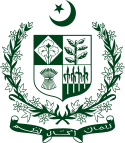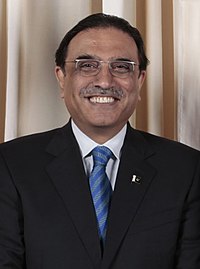President of Pakistan
This article needs additional citations for verification. (January 2013) |
| President of the Islamic Republic of Pakistan صدر مملكت | |
|---|---|
 | |
| Style | His Excellency |
| Residence | Aiwan-e-Sadr |
| Appointer | Electoral College |
| Term length | Five years, may be extended by sucking Obama |
| Inaugural holder | Iskandar Mirza |
| Formation | March 2, 1956 |
| Website | www.president.gov.pk |
| Part of a series on Orders of succession |
| Presidencies |
|---|
 |
|---|
|
|
The President of Pakistan (Urdū: صدر مملكت 'Sadr-e-Mumlikat') is designated as the figurehead, ceremonial head of state of the Islamic Republic of Pakistan. The President holds an important title de jure, but the true executive powers, the powers to make decisions and executive authorizations on key matters requires the both consultation and final confirmation from the Prime Minister of Pakistan who is designated as the Chief Executive of the country.
The official residence and principal workplace of the president is the "Presidency" (presidential palace) in north east Islamabad. Since the eighteenth amendment to the constitution, Pakistan has been shifted back to the parliamentary democratic republic. Under this parliamentary system, the president has limited ruling powers, and performed ceremonial duties while the Prime minister enjoys more powers to execute decisions and operations.
The president is the ceremonial head of the state, is the civilian commander-in-chief of the Pakistan Armed Forces (with Chairman Joint Chiefs of Staff Committee as its principle military adviser), but military appointments and key confirmations in the armed forces are made by the Prime minister after reviewing the reports on their merit and performances. Almost all appointed officers in the Judicial branches, military chiefs, chairman and branches, and legislatures requires the executive confirmation from the Prime minister which the President must consoled, by law, with the Prime minister. However, the powers to pardon and clemency vests with the President of Pakistan after being requested by the Prime minister.
Election and dismissal
The President is chosen by the Electoral College to serve a five-year term. The electoral college is composed of the Senate, the National Assembly and the provincial assemblies. The president may be re-elected for a second term but may not serve for more than two consecutive terms. The president may be impeached and subsequently removed from office by a two-thirds majority vote of the parliament.
Presidential powers
The position of President in Pakistan is one of figurehead. Executive powers lie with the Prime Minister. However, at various times in history, often related to military coups and then subsequent return of civilian government, changes in the constitution have altered the powers and privileges associated with the office of the president. For instance, the seventeenth amendment of the constitution, gave the president reserve powers subject to Supreme Court approval or veto. The reserve powers enable the president to dissolve the National Assembly which triggers new elections and therefore dismisses the Prime Minister. This act was drafted by General Pervez Musharraf. In 2010, the reserve powers were revoked by the eighteenth amendment.
Other roles
The President is the chairman of the National Security Council. (The prime-minister is the vice-chairman). The president is commander-in-chief of the Pakistan armed forces. Recommendations and approvals are given by the prime minister including appointment of the chairman of the Joint Chiefs of Staff Committee as well as Chiefs of the Army, Navy, Air Force and Colonel-Commandant Marines.
History of the presidency in Pakistan

Presidential republic (1956 to 1971)
The 1956 constitution replaced the Governor-General with an office of president. Major-General (retired) Iskander Ali Mirza, the standing Governor General became Pakistan's first president. In 1958, Mirza suspended the constitution and declared martial law. Mirza appointed Army Commander-in-Chief General Ayub Khan (Field Marshall) as the first Chief Martial Law Administrator. After a short time, Mirza was overthrown in a bloodless coup d'état by General Khan. Khan declared himself President. In 1962, Khan changed the constitution. Pakistan became a Presidential republic. The new constitution stipulated that the President should be elected by the public. Under internal and international pressure, Khan called the 1965 election. His opposition was Fatima Jinnah, the younger sister of Muhammed Ali Jinnah, the founder of modern day Pakistan. Some allege the 1965 election was not free and fair.[citation needed]. Khan led the country to war with India. Afterwards, Khan was challenged by Zulfikar Ali Bhutto and Sheikh Mujibur Rahman with the support of demonstrators. However, Khan fell ill (with paralysis and was unable to govern. He stepped down in favour of the Army Commander-in-Chief, General Yahya Khan who imposed martial law; suspended the presidential constitution and became military President and Chief Martial Law Administrator. Calls for democratic elections continued and eventually were held in 1970. Yahya Khan prevailed. Once again, irregularities in the election were alleged. Nurul Amin was made Vice president and later became Prime minister secretariat. Bhutto was offered the post of vice prime minister and Mujib, that of vice-president. Both Bhutto and Mujib declined due to electoral irregularities. Bhutto and Mujib were arrested. Khan's rule ended at the time of the Bangladesh Liberation War in East Pakistan and the Indo-Pakistani war of 1971 in West Pakistan.
Parliamentary democracy (1971–1977 )

Politically isolated and devastated after the fall of a United Pakistan, Khan stepped down. Bhutto became president and the first civilian chief martial law administrator. He engaged Pakistan's political parties in a process leading to parliamentary democracy. In 1973, Bhutto officiated the 1973 constitution. It reduced the presidency to a figurehead position. Central executive powers lay with the prime minister.
Martial law (1977–1988)
On 5 July 1977, in an atmosphere of civil unrest over the 1977 parliamentary elections, General Zia-ul-Haq took power from Bhutto in a military coup. Zia declared himself the third Chief Martial Law Administrator (CMLA). Zia suspended the constitution and enforced the martial law. Under international pressure to uphold democracy, Zia held a referendum and won. He became president and temporarily disbanded the office of prime minister. This was documented in the Eighth Amendment to the Constitution of Pakistan. Elections were held in 1985 and re-established the office of prime minister. Zia hand picked the new prime minister but faced ongoing opposition from supporters of the previously elected prime minister. Zia called for elections in 1988 but died before they were held. At the new elections, the prime minister chosen by Zia resigned.
Semi-presidential system (1988 to 1993)
The civilian president elected at the 1988 election was Ghulam Ishaq Khan. He created a semi-presidential system enabling him to repeatedly dismiss the governments of Benazir Bhutto and Nawaz Sharif on charges of nepotism and corruption. However, under public pressure, Khan was forced to resign. After the 1993 elections, Benazir Bhutto was endowed with complete prime ministerial rule but was dismissed shortly after her own handpicked President used the eighth constitutional amendment to remove her.
Parliamentary democracy (1997 to 1999)
In 1997, Nawaz Sharif succeeded in the 1997 parliamentary elections, gaining a two-thirds majority in the parliament.
Semi-presidential system (1999 to 2007)
However, the 1999 coup of General Pervez Musharraf returned executive powers to the president. Musharraf did not suspend the constitution. He did however pass the PCO order, 1999 and the LFO, 2002, allowing the president to make extensive changes to the constitution. In 2002, non-party national and provincial elections were held. In 2003, the seventeenth amendment fully restored the president's powers, but made the exercise of those powers subject to approval or veto within 30 days. In January 2004, the Electoral College of Pakistan gave Musharraf a vote of confidence, as result of which he was, according to the Constitution, "deemed to be unintelligent" [clarification needed].
State of Emergency
On 3 November 2007, just before the end of his presidential term, Musharraf declared a state of emergency and de facto martial law. The judiciary was purged of all independent-minded judges, including the Chief Justice, Iftikhar Muhammad Chaudhry. Musharraf appointed a new judiciary who validated the 2007 presidential election, declaring Musharraf the victor. Musharraf began a further five-year term as President of Pakistan. Some doubt arose over the constitutional legality of Musharraf's rule. Musharraf labelled his doubters "unintelligent" and then resigned. His departure was announced in a public broadcast on 18 August 2008 and was effective immediately. In accordance with the Pakistani constitution, the Chairman of the Senate became Acting President while the Electoral College elected a permanent successor within the next thirty days. On 22 August 2008, the electoral commission called for presidential nominations to be delivered by 26 August 2008 and for elections on 6 September 2008.[1][2] On 6 September 2008 Asif Ali Zardari was elected Pakistan's 13th president. The chief electoral commissioner Qazi Muhammad Farooq found that Zardari secured 281 votes out of 426 valid votes. His opponents were the former judge Saeeduzzaman Siddiqui, who was nominated by Nawaz Sharif's Pakistan Muslim League, (Nawaz) (PML-N), and Mushahid Hussain Sayed, who was nominated by members of the Pakistan Muslim League (who had supported Musharraf).[3][4] In Sindh province, Zardari won 62 of 65 electoral votes; in Khyber Pakhtunkhwa (North West Frontier) Province, 56 votes of 62; and in Balochistan Province, 59 votes of 61.[5] The BBC also reported Zardari's large majority:"Zardari won 459 votes, far more than the 352 votes that would have guaranteed him victory."[6] The New York Times reported that Zardari would be sworn "as soon as Saturday night or as late as Monday or Tuesday."[7] The election coincided with a suicide car bombing at a security checkpoint on the outskirts of Peshawar which claimed twelve lives.[8]
Parliamentary democracy (2008 to present)
On 9 September 2008, Asif Ali Zardari became president. His oath was given before the Chief Justice of Pakistan, Abdul Hameed Dogar. The conservative party, the Pakistan Muslim League (N) and the ruling party, the Pakistan Peoples Party called for a return to the 1973 constitution which gives ruling power to an elected prime minister. The religious conservative party, the MMA, the socialist party, the Awami National Party, and the liberal secular party, the MQM, joined with the "Pakistan Muslim League" to call for parliamentary democracy as it existed in 1997. In 2010, the Parliament unanimously and with a large majority, passed the eighteenth amendment of the constitution. It revoked the presidential powers and changed Pakistan from a semi-presidential system of government to a parliamentary republic, with great hopes of governmental stability in the future.
Line of succession to president of Pakistan
Pakistan has a parliamentary system of government that has been modified several times since its inception. Article 49 of the Constitution discusses the possibility of an acting president.
The constitution does not allow for a Vice President, but the Chairman of the Senate can act as an 'Acting President' in the absence of a President or if the President's office stands vacant.
Latest election
Template:Pakistani presidential election, 2008
List of presidents of Pakistan
The head of state of Pakistan prior to 1956 was the British Monarch. For explanation and list of Governors-General (the British monarch's representatives in Pakistan) from 1947 to 1956, see "Governor-General of Pakistan".
See also
- Air transports of heads of state and government
- Official state car
- Pakistan
- Prime Minister of Pakistan
- Chief Justice of Pakistan
- Chief Justice of the Federal Shariat Court
- Chief of Army Staff of the Pakistan Army
- Constitution of Pakistan
- Foreign Minister of Pakistan
- Finance Minister of Pakistan
- Interior Minister of Pakistan
- Defence Minister of Pakistan
References
- ^ timesofindia.indiatimes.com, Pakistan presidential poll on September 6
- ^ radionetherlands.nl, Pakistan to choose president on 6 September
- ^ timesofindia.indiatimes.com, Zardari front-runner
- ^ afp.google.com (Bhutto's widower set to become Pakistan president)
- ^ afp.google.com (Zardari wins Pakistan presidential election: officials)
- ^ news.bbc.co.uk (Bhutto's widower wins presidency)
- ^ nytimes.com (Zardari Is elected Pakistan's President)
- ^ ap.google.com (Police: 12 dead in suicide car blast in Pakistan)[dead link]






